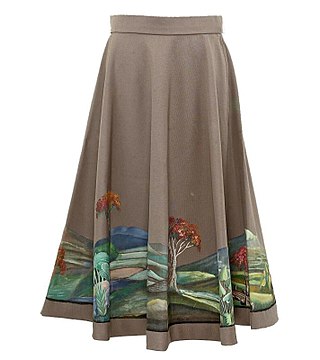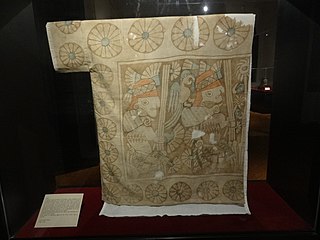Related Research Articles

A draped garment is a garment that is made of a single piece of cloth that is draped around the body; drapes are not cut away or stitched as in a tailored garment. Drapes can be held to the body by means of knotting, pinning, fibulae, clasps, sashes, belts, tying drawstrings, or just plain friction and gravity alone. Many draped garments consist of only one single piece.

A skirt is the lower part of a dress or a separate outer garment that covers a person from the waist downwards.

A coat is typically an outer garment for the upper body, worn by either gender for warmth or fashion. Coats typically have long sleeves and are open down the front, and closing by means of buttons, zippers, hook-and-loop fasteners, toggles, a belt, or a combination of some of these. Other possible features include collars, shoulder straps, and hoods.
Clothing in India varies with the different ethnicities, geography, climate, and cultural traditions of the people of each region of India. Historically, clothing has evolved from simple garments like kaupina, langota, achkan, lungi, sari, to rituals and dance performances. In urban areas, western clothing is common and uniformly worn by people of all social levels. India also has a great diversity in terms of weaves, fibers, colors, and the material of clothing. Sometimes, color codes are followed in clothing based on the religion and ritual concerned. The clothing in India also encompasses a wide variety of Indian embroidery, prints, handwork, embellishments, and styles of wearing clothes. A wide mix of Indian traditional clothing and western styles can be seen in India.

A petticoat or underskirt is an article of clothing, a type of undergarment worn under a skirt or a dress. Its precise meaning varies over centuries and between countries.

Quechua people or Quichua people may refer to any of the indigenous peoples of South America who speak the Quechua languages, which originated among the Indigenous people of Peru. Although most Quechua speakers are native to Peru, there are some significant populations in Ecuador, Bolivia, Chile, Colombia, and Argentina.

The robe à la polonaise or polonaise is a woman's garment of the later 1770s and 1780s or a similar revival style of the 1870s inspired by Polish national costume, consisting of a gown with a cutaway, draped and swagged overskirt, worn over an underskirt or petticoat. From the late 19th century, the term polonaise also described a fitted overdress which extended into long panels over the underskirt, but was not necessarily draped or swagged.

A Mother Hubbard dress is a long, wide, loose-fitting gown with long sleeves and a high neck. It is intended to cover as much skin as possible. It was devised in Victorian western societies to do housework in. It is mostly known today for its later introduction by Christian missionaries in Polynesia to "civilise" those whom they considered half-naked savages.
The study of the history of clothing and textiles traces the development, use, and availability of clothing and textiles over human history. Clothing and textiles reflect the materials and technologies available in different civilizations at different times. The variety and distribution of clothing and textiles within a society reveal social customs and culture.

A justacorps or justaucorps is a knee-length coat worn by men in the latter half of the 17th century and throughout the 18th century. The garment is of French origin, and was introduced in England as a component of a three-piece ensemble, which also included breeches and a long vest or waistcoat. This ensemble served as the prototype of the frock coat, which in turn evolved into the modern-day three-piece suit.

The preservation of fabric fibers and leathers allows for insights into the attire of ancient societies. The clothing used in the ancient world reflects the technologies that these peoples mastered. In many cultures, clothing indicated the social status of various members of society.

The Andean textile tradition once spanned from the Pre-Columbian to the Colonial era throughout the western coast of South America, but was mainly concentrated in Peru. The arid desert conditions along the coast of Peru have allowed for the preservation of these dyed textiles, which can date to 6000 years old. Many of the surviving textile samples were from funerary bundles, however, these textiles also encompassed a variety of functions. These functions included the use of woven textiles for ceremonial clothing or cloth armor as well as knotted fibers for record-keeping. The textile arts were instrumental in political negotiations, and were used as diplomatic tools that were exchanged between groups. Textiles were also used to communicate wealth, social status, and regional affiliation with others. The cultural emphasis on the textile arts was often based on the believed spiritual and metaphysical qualities of the origins of materials used, as well as cosmological and symbolic messages within the visual appearance of the textiles. Traditionally, the thread used for textiles was spun from indigenous cotton plants, as well as alpaca and llama wool.

The Andean civilizations were South American complex societies of many indigenous people. They stretched down the spine of the Andes for 4,000 km (2,500 mi) from southern Colombia, to Ecuador and Peru, including the deserts of coastal Peru, to north Chile and northwest Argentina. Archaeologists believe that Andean civilizations first developed on the narrow coastal plain of the Pacific Ocean. The Caral or Norte Chico civilization of coastal Peru is the oldest known civilization in the Americas, dating back to 3500 BCE. Andean civilization is one of the six "pristine" civilizations of the world, created independently and without influence by other civilizations.

An overskirt is a type of women's short skirt which is draped over another garment, such as a skirt, breeches, or trousers. Although peplum is often used as another term for overskirt, it should not be confused with the peplos or "peplum dress", which was worn in ancient Greece.

The Otavalos are an indigenous people native to the Andean mountains of Imbabura Province in northern Ecuador. The Otavalos also inhabit the city of Otavalo in that province. Commerce and handcrafts are among the principal economic activities of the Otavalos, who enjoy a higher standard of living than most indigenous groups in Ecuador and many mestizos of their area.

Pomasqui Valley is a valley on the northern outskirts of Quito, Ecuador. It is located on the equator, the so-called "Mitad del Mundo", at an altitude of around 2,600 metres (8,500 ft) above sea level. Hot and semi-arid, it is formed by a river tributary. The valley contains the Cerro de Catequilla, which contains the pre-Columbian astronomical observatory, Catequilla. The village of Pomasqui itself lies roughly 6 kilometres (3.7 mi) from the equator. The Monjas River flows nearby and the valley is an important centre for viniculture in Ecuador, with vineyards. The economy features vegetable and fruit production. To the northwest is the Pululahua Geobotanical Reserve.

Uncu (Unku) was a men's garment of the Inca Empire. It was an upper-body garment of knee-length; Royals wore it with a mantle cloth called ''yacolla.'' Women wore a long dress known as an anaku.
Yacolla was an outer garment in the Inca men's clothing that was similar to a mantle worn over the Uncu.
Worn for over 1700 years throughout the Andean regions of South America, tupu pins were worn primarily by women.
References
- 1 2 Meisch, Lynn A. (2012-10-03). Costume and History in Highland Ecuador. University of Texas Press. p. 309. ISBN 978-0-292-74985-6.
- ↑ Jarvis, Kathy (2000). Ecuador, Peru & Bolivia : the backpacker's manual. Internet Archive. Guilford, CT : Globe Pequot Press. p. 75. ISBN 978-1-898323-95-2.
- 1 2 Schevill, Margot Blum; Berlo, Janet Catherine; Dwyer, Edward B. (2010-07-05). Textile Traditions of Mesoamerica and the Andes: An Anthology. University of Texas Press. pp. 150, 154, 158. ISBN 978-0-292-78761-2.
- ↑ Meisch, Lynn (2002). Andean entrepreneurs : Otavalo merchants and musicians in the global arena. Internet Archive. Austin : University of Texas Press. p. 243. ISBN 978-0-292-75258-0.
- ↑ Meisch, Lynn A. "South America: History of Dress". LoveToKnow. Retrieved 2021-06-04.
- ↑ Colloredo-Mansfeld, Rudolf Josef (1999). The native leisure class : consumption and cultural creativity in the Andes. Internet Archive. Chicago : University of Chicago Press. p. 13. ISBN 978-0-226-11394-4.
- ↑ "Indigenous clothing changes in the Andean highlands under Spanish colonialism" (PDF).